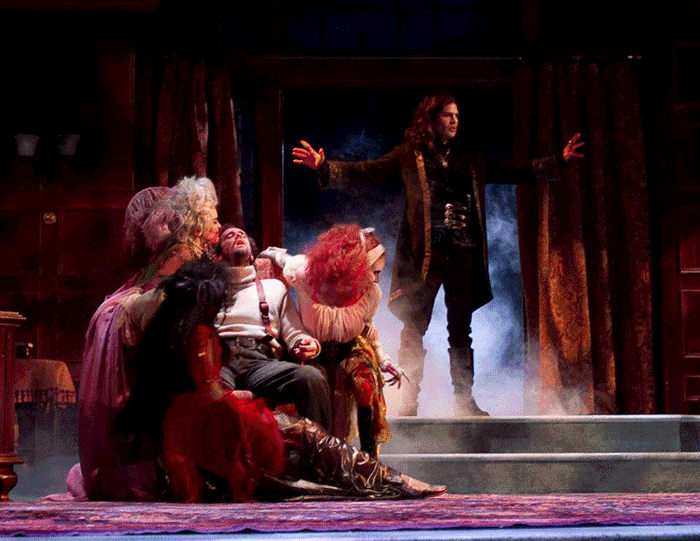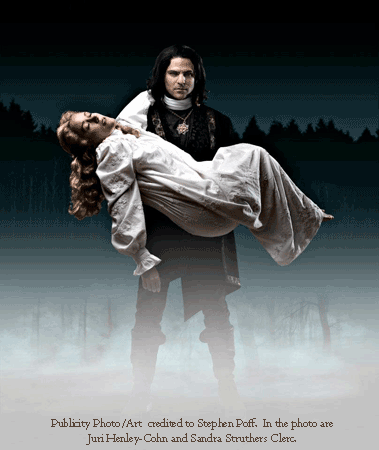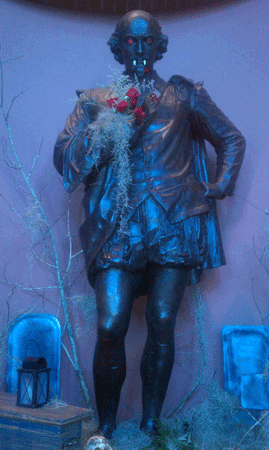Essays Current Research ReviewsContributorsAnnouncements
Home
ISSN 2045-1024
Dracula
reviewed by Kristin C. Ross, Troy University
Dracula, originally dramatized by John L. Balderston and Hamilton Deane from Bram Stoker’s Dracula, adapted by William McNulty from Bram Stoker’s Dracula and presented by the Alabama Shakespeare Festival on the Festival Theatre Stage, Montgomery, Alabama, October 7-30, 2011. Directed by Geoffrey Sherman. Composed by Brett Rominger. Scenic Design by Peter Hicks. Costume Design by Pamela Scofield. Lighting Design by Matthew McCarthy. Sound Design by Richelle Thompson. Dramaturg Susan Willis. With Juri Henley-Cohn (Count Dracula), Paul Hebron (Abram Van Helsing), Keith Merrill (Thomas Seward), Mairin Lee (Lucy Westphal), John P. Keller (Jonathan Harker), Greg Jackson (Robert Renfield), Jennifer Barnhart (Margaret Sullivan), Brik Berkes (Norbert Briggs), Craig Hanson (Monster), and others.

In the photo are: Bliss Griffin, Laura Bozzone, John P. Keller, Candace Scholz, and Juri Henley-Cohn.
Ringing gunshots, bursting lights, exploding coffins, levitating characters, and live rodents are just some of the exciting effects used to jolt the audience out of its complacency that the Alabama Shakespeare Festival (ASF) production of Dracula is mere fantasy and not a real, supernatural occurrence. Adapted by William McNulty in 2008, the play opens to the Monster—in full-head creature mask—attacking Mina then transforming into the young, human Count Dracula and engaging in a graveyard waltz with her. From this moment, the audience is utterly taken by the hypnotic world of vampirism and vampire-hunting. The advertising for the play warns that the performance is recommended for those over 13 “due to graphic depictions of violence and the supernatural.” This warning initially seemed more a wink-and-nod rather than true caveat; however, this was no ploy. The explosions are unexpected and do frighten—those in attendance gasped more than a few times at them—and the rat thrown into the audience (albeit fake in this scene of the play, though not in others) forced some people nearly out of their seats. In the capable hands of Director Geoffrey Sherman, this performance delivered everything it promised and more.
The play is based on Bram Stoker’s Dracula (1897) and was adapted from the Hamilton Deane and John L. Balderston dramatization, Dracula: the Vampire Play in Three Acts (1927). The Deane and Balderston dramatization condenses the characters in Stoker’s novel down to a mere handful. The troika of suitors for Stoker’s Lucy, for instance, is whittled down to John Seward. The characters of Lucy and Mina are transposed—the result of copyright issues—with Mina dying before the play opens and Lucy Seward, rather than Lucy Westenra, as the central female character. These changes and transpositions fix Jonathan Harker as the fiancé of Lucy, rather than Stoker’s Mina. Renfield, Van Helsing, and Dracula are preserved in the Deane and Balderston adaptation. Much of the changes in character Deane and Balderston introduce are maintained in the McNulty adaptation with slight alterations in names. In an interview, McNulty says he adapted the 1927 play at the request of Marc Masterson, former Artistic Director for the Actors Theater of Louisville. The intent of the adaptation was to update the language to give it a modern sensibility but to leave the Victorian style intact. In doing so, he hoped to make the characters more plausible to today’s audiences.
 If the ASF performance of McNulty’s adaptation is any indication, McNulty accomplished his aim. It succeeded in capturing the air of Victorianism but achieved the realism necessary to draw the audience into the action of the play. McNulty’s script distinctly specifies that there is “nothing campy or romantic” about the character of Dracula and that he does not find “a powerful male figure who brutally attacks young women” “funny, attractive, or in any way sympathetic.” McNulty exhorts his actors to play this role accordingly. The brooding good looks of Juri Henley-Cohn, as Count Dracula, would seem incompatible with this direction. However, not so; he was compelling, and in all reality, who can expect something so utterly evil not to have some allure working in its favor? He deftly succeeded in not invoking sympathy or campiness, and his impressive, preternatural mid-air flights onto and off of furniture left the audience questioning what manner of man Henley-Cohn is.
If the ASF performance of McNulty’s adaptation is any indication, McNulty accomplished his aim. It succeeded in capturing the air of Victorianism but achieved the realism necessary to draw the audience into the action of the play. McNulty’s script distinctly specifies that there is “nothing campy or romantic” about the character of Dracula and that he does not find “a powerful male figure who brutally attacks young women” “funny, attractive, or in any way sympathetic.” McNulty exhorts his actors to play this role accordingly. The brooding good looks of Juri Henley-Cohn, as Count Dracula, would seem incompatible with this direction. However, not so; he was compelling, and in all reality, who can expect something so utterly evil not to have some allure working in its favor? He deftly succeeded in not invoking sympathy or campiness, and his impressive, preternatural mid-air flights onto and off of furniture left the audience questioning what manner of man Henley-Cohn is.
The humor in the play is reserved for Renfield, outstandingly played by Greg Jackson. Renfield’s hesitance to reveal the true nature of his malady, evident in his frequent handwringing and his beautifully crafted stutter, coupled with his ardent desire to be free of Dracula’s hold were brilliantly apprehended by Jackson. Paul Hebron as Abram Van Helsing underscored the contrast between the character of Stoker’s novel, who tends to be emotionally detached at times, and McNulty’s character, whose facial expressions displayed such empathy in persuading Seward away from his contemplation of suicide late in the play. Mairin Lee, as Lucy Westphal, and John P. Keller, as Jonathan Harker, brought as much to their roles as could be expected, given the bourgeois propriety of their characters. However, the class differences in the play were punctuated by Brik Berkes as Norbert Briggs and Jennifer Barnhart as Miss Sullivan. Berkes’s near-Cockney dialect, absenting the letter “h,” worked well with the occasional bouts of brutality he displayed in chasing and wrestling Renfield into submission. Barnhart rivaled Berkes in highlighting the class differences, displaying wide-ranging vocal inflection and the sweeping movement and largeness of gesture characteristic of a woman less schooled in Victorian modesty. She owned the stage with her presence.
 Nicely complementing the acting was a set that showed considerable attention to detail. Seward’s study was meticulously fashioned, with rows of books lining the shelves. The catacombs in the last act of the play worked seamlessly with the fog and lighting to render a dank atmosphere, and the sound reinforced this setting with initial reverb that quietly faded as the scene progressed so as not to be distracting. The costuming and makeup highlights included the aforementioned full-head creature mask. The wardrobe choice for Harker’s character, however, seemed somewhat perplexing, perhaps due to what may have been some confusion in the script, which at one point indicates that Harker resembles Robinson Crusoe but, at others, has him working on a steamer. The thin mock turtle neck, suspenders, and somewhat delicate, scuffed boots with no laces suggested something other than deserted islander or working-class shipman. The Brides’ costumes also indicated an interesting departure from the script, which specifies that they be seductive. Yet the costuming and makeup choices were more clownish than provocative. The fight scenes also deserve note, as they were intricately choreographed between characters animated by invisible force rather than touch. The timing for these was flawless.
Nicely complementing the acting was a set that showed considerable attention to detail. Seward’s study was meticulously fashioned, with rows of books lining the shelves. The catacombs in the last act of the play worked seamlessly with the fog and lighting to render a dank atmosphere, and the sound reinforced this setting with initial reverb that quietly faded as the scene progressed so as not to be distracting. The costuming and makeup highlights included the aforementioned full-head creature mask. The wardrobe choice for Harker’s character, however, seemed somewhat perplexing, perhaps due to what may have been some confusion in the script, which at one point indicates that Harker resembles Robinson Crusoe but, at others, has him working on a steamer. The thin mock turtle neck, suspenders, and somewhat delicate, scuffed boots with no laces suggested something other than deserted islander or working-class shipman. The Brides’ costumes also indicated an interesting departure from the script, which specifies that they be seductive. Yet the costuming and makeup choices were more clownish than provocative. The fight scenes also deserve note, as they were intricately choreographed between characters animated by invisible force rather than touch. The timing for these was flawless.
This production was deliciously wicked. While no play based on Stoker’s lengthy novel can completely embody the work in its entirety, the ASF performance grabbed its essence. It brought characters who epitomize the conflict between good and evil to life for an audience over 100 years removed from their creation. It also made us believe that the incredible might actually be possible as we adjusted our neck scarves on the way out of the theatre and passed by the sculpture of Shakespeare in the lobby—appropriately fanged and transformed into one of the undead.
Permission to use the photographs has been granted by Meg Lewis, Director of Marketing and Communications at the Alabama Shakespeare Festival.